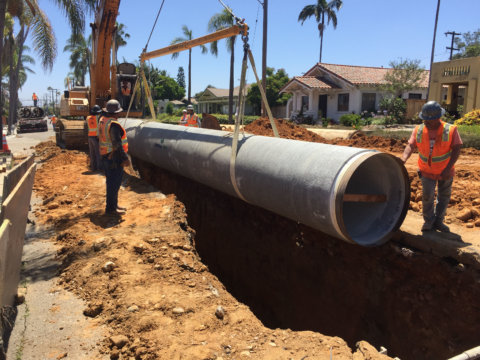
The 30th Street Pipeline Replacement Project enabled several positive changes in the North Park, South Park, and Golden Hill communities of San Diego, and RICK was honored to be a part of it. Innovative design methods and extensive community outreach ensured the best possible outcome for surrounding residences, businesses, and habitats, all through the collaborative efforts of the City of San Diego, Ortiz Construction, RICK, and RICK’s numerous subconsultant partners. Now being recognized with multiple awards, this project tells the story of how innovation, collaboration, and community involvement came together to make a difference.
RICK’s Nick Dorner served as Project Manager and Kevin Gibson was the Principal-in-Charge for this five-mile water main replacement project, which wound through densely populated neighborhoods and residential areas. Through the efforts of the entire project team, the pipeline now provides reliable, clean water to the community, and locals are enjoying opportunities for alternative transportation with improved streets and widened bike lanes. 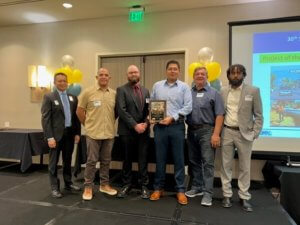 With more than just the outcome in mind, the team considered community needs and the local environment every step of the way, from design through construction.
With more than just the outcome in mind, the team considered community needs and the local environment every step of the way, from design through construction.
The 30th Street Pipeline project received two awards this month: ASCE Outstanding Water Project and APWA Project of the Year. RICK was grateful to be deeply involved with the project and valued the opportunity to collaborate and create with such a highly skilled team.
Community Outreach
With the expert guidance of CityWorks, the project’s public outreach consultant, the team navigated complicated residential and commercial concerns: local businesses affected by the construction needed to stay open late to remain profitable, and residents were concerned about daytime construction noise. Maintaining access for vehicles, bicycles, and pedestrians also posed a concern with another project in construction nearby.
“This community was incredibly dense and coordinating the best times for construction took significant consideration to ensure minimized impacts to residents and local businesses.” —Nick Dorner, PE, RICK Associate
The team performed extensive outreach throughout the project to keep community groups, business improvement districts, schools, and other stakeholders informed. From the outset of the design phase through the completion of construction, a dedicated Public Information Officer provided monthly e-blasts and notification letters to the community during the design and construction phases to keep the community informed of the project’s progress.
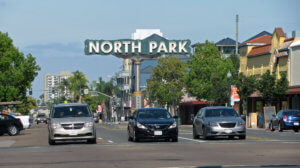
The project team also met with community groups, business improvement districts, residents, and businesses. The team held a total of 15 community outreach events with various groups, including an “open house” event, allowing residents to express their concerns and give input. Along with placing advanced signage and regular notifications, CityWorks staff went door to door to speak with residents.
Innovative Design
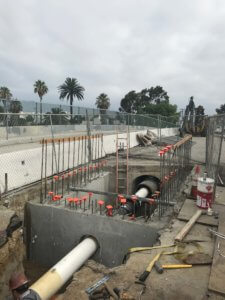 The team evaluated alternative installation alignments to minimize impacts to utilities, maintain access to homes and businesses, and reduce costs for the City. Additionally, the team determined the best time for construction, minimizing disruption to as many groups as possible.
The team evaluated alternative installation alignments to minimize impacts to utilities, maintain access to homes and businesses, and reduce costs for the City. Additionally, the team determined the best time for construction, minimizing disruption to as many groups as possible.
Thanks to expert designers, the once deteriorating and asbestos-filled pipeline now prevents future service disruptions and water main breaks. This means less road blockage and construction noise for locals. Improvements have also provided a reliable water supply to residents and businesses, so citizens no longer worry about the quality of their water.
Even when the team was faced with unexpected existing conditions, part of the old pipeline was repurposed into a casing for the new one, saving time and money. As a result of this quick thinking, the portion of the pipeline crossing over State Route 94 was replaced without the need for reconstruction of the bridge deck, shortening the construction schedule.
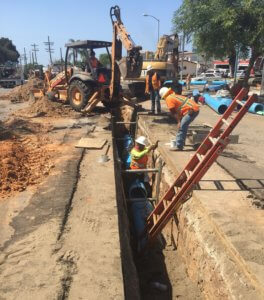 Environmental Considerations
Environmental Considerations
Part of the pipeline replacement took place in Switzer Canyon, which is home to sensitive bird species, including the California Gnatcatcher. The team scheduled construction activities around breeding seasons and performed nesting surveys to avoid affecting the sensitive birds. Also, since the streets along the whole of the site are lined with mature pepper trees, the large machinery used in construction risked damage to them. With individuals on site dedicated to keeping a close eye on the trees, they are all still standing today.
Mobility Enhancement
Contributing to the City of San Diego’s goal to increase mobility options and expand bike lanes, the project team also installed bike lanes along 30th Street, from Polk Avenue to Juniper Street, providing an essential connection for bicycle infrastructure and more room to breathe for the large volume of local bikers. These improvements were consistent with SANDAG’s regional bikeway master planning.